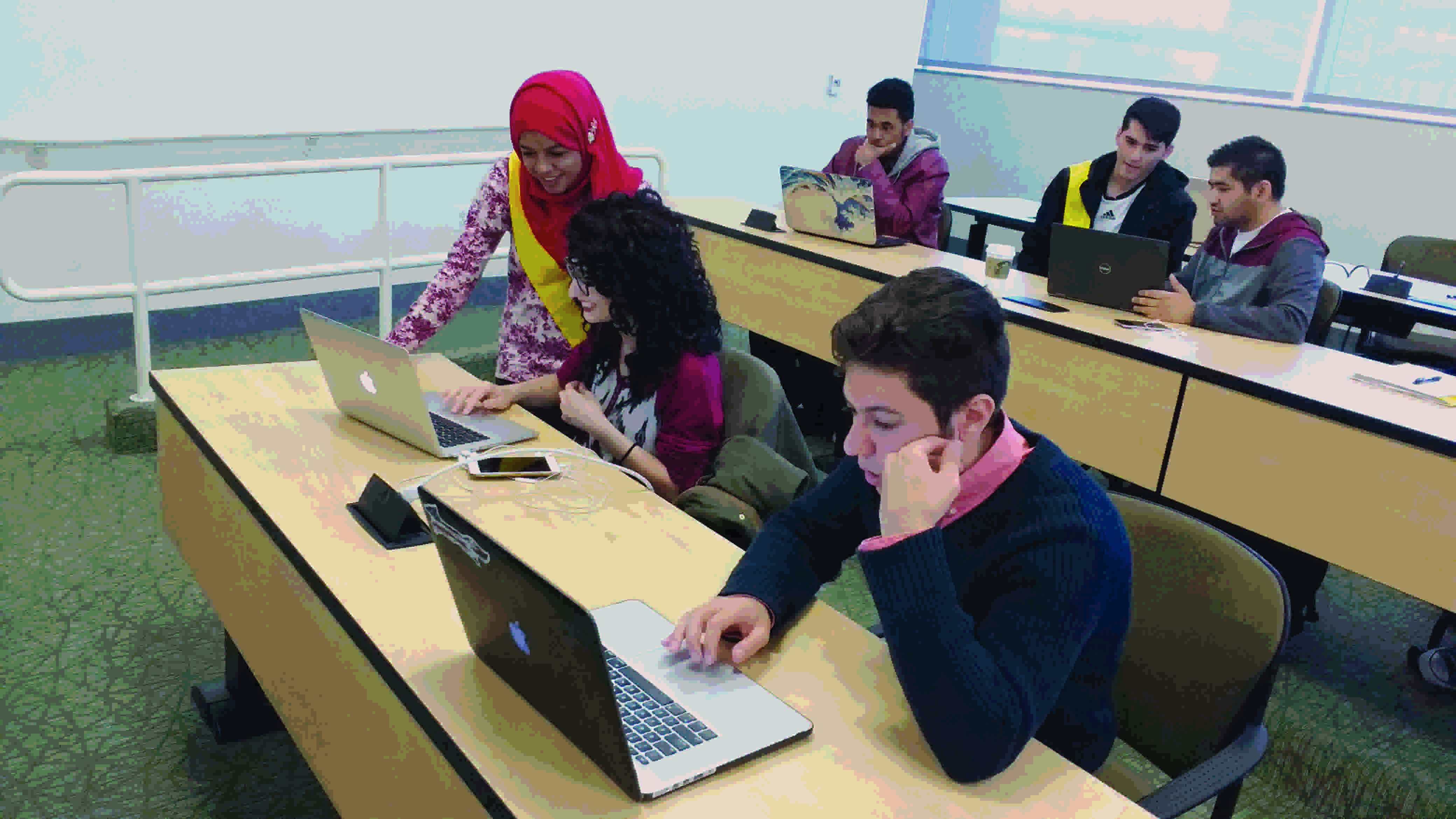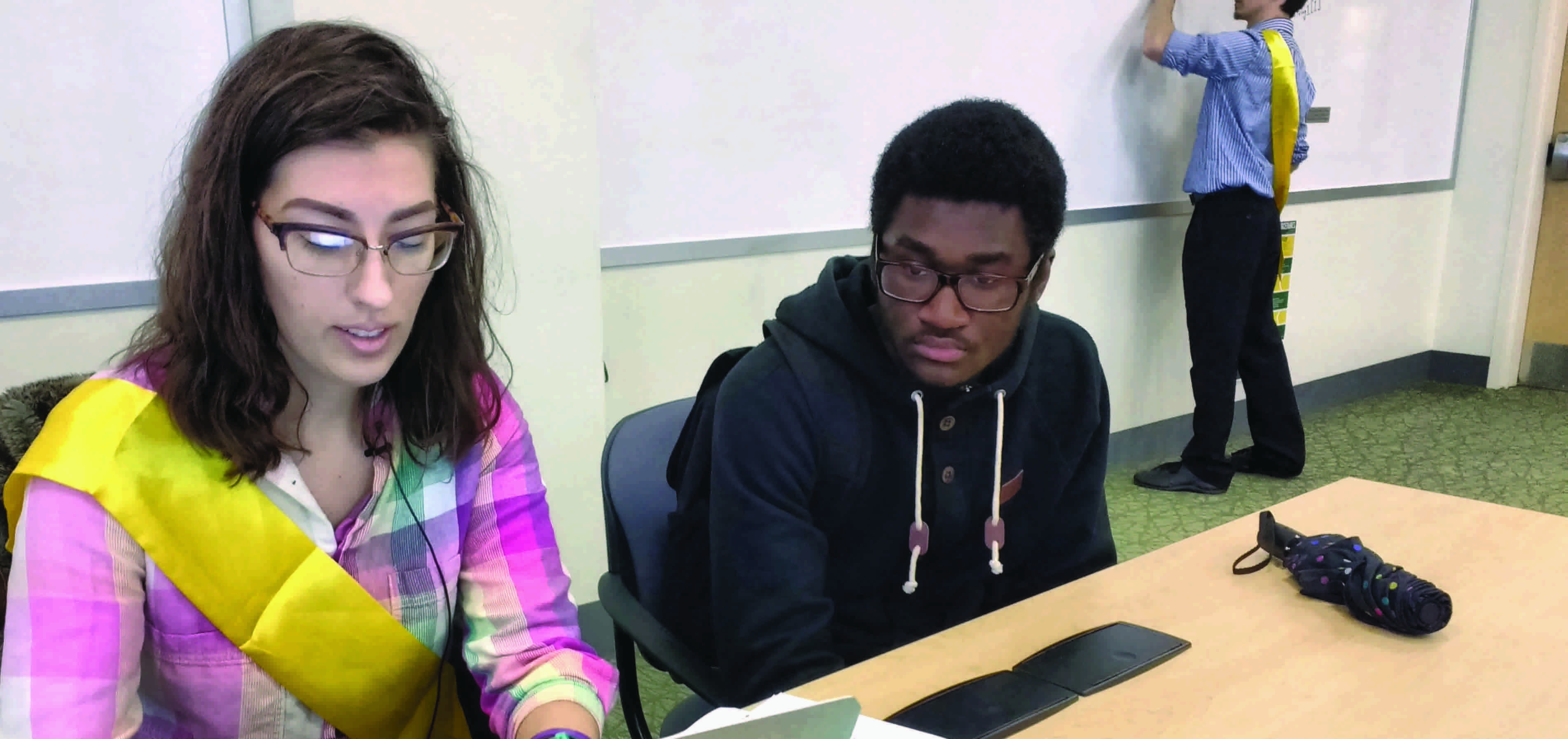
The Fall 2015 semester at George Mason University’s Department of Computer Science brought a new kind of study and research. A research question, a challenge of sorts, was posed to the department by Google. The tech giant sent out a targeted research request to universities across the country. The goal is to find a way to triple the number of students completing a CS class while also increasing the appeal to non- traditional CS students, minorities, and women, without additional faculty or high dollar resources.
Shifting pedagogical models such as distance learning, flipped classrooms, self-study, and accelerated, executive advanced degree programs are on the rise as students and early career professionals seek specialized training from their college experience and dollars. The workforce is demanding it too — and nowhere more so than in the tech sector. The world’s most innovative tech companies are searching for top talent and they are looking to build a more diverse workforce. Diversity, in the form of minorities and women, increases productivity and creativity. But how do you attract these desirable minds to an industry that has a strong cultural bias against them? The answer lies somewhere in changing the culture.
Jeff Offutt, Professor of Software Engineering, along with several department colleagues, had been discussing ways to improve and change how entry-level CS classes were taught. This awareness was a jump-start to the proposal. Offutt says it was a true team effort and needed to be because the problem involved the culture of the department, deconstructing and understanding how courses where taught, how students could learn, what they needed to learn, all while being able to measure the outcomes. A people-centric problem needed the ideas and voices of a lot of people. Google received twenty-five submissions and selected six, including Mason. The resulting winning proposal, Self-Paced Learning Increases Retention and Capacity—SPARC, is a three-year $900,000 Google Computer Science Capacity Award grant.
SPARC IGNITION
By some estimates, the culture inherent in the technology industry begins in middle school where the number of girls in STEM classes shifts. We lose girls early. We also lose lower income minorities who may not have the same access to technology. The American Association of University Women (AAUW) reports that by the time students begin college, there is an 80/20 split of men to women in STEM classes. It’s even lower for computer science classes with only twelve percent of women taking them. But women and minorities do go to college. And they graduate with advanced degrees in science and business, fields that also require mathematics and computers. We have the students. We need to find a way to change how they perceive CS and how the material is taught.
This national problem makes George Mason University an ideal research institution for the SPARC model. The school is located in the heart of the Washington, D.C., technology hub and has one of the most ethnically diverse populations in Virginia. The CS Department has seen an almost triple increase in the number of incoming new students from 109 in Fall 2011 to 279 in Fall 2015. The CS department also has a comparatively large number of female professors who serve as positive role models and mentors.
The SPARC team includes CS professors Jeff Offutt (project PI), Paul Ammann, Kinga Dobolyi, Huzefa Rangwala, Liz White, Pearl Wang, Sanjeev Setia, Chris Kaufmann, Mark Snyder, Yutao Zhang, and Jaime Lester who teaches higher education in the College of Humanities and Social Sciences. Lester, Offutt, Rangwala, Dobolyi, and Snyder are Mason Teaching Excellence Award winners.
Lester’s involvement, by the team’s own admission, has provided the glue to the process. While the CS faculty is immersed in the coursework, handling challenges faced by students, and coming up with fresh ideas, Lester helps to vet the ideas as they relate to a classroom while also offering changes and improvements. She also helps analyze the data in comparison to the control classes.
Offutt says that the concept for the new class grew organically from the group as everyone talked about what they would like to see and ways they could measure student success. The plan developed called for self-paced learning, online assessments, peer- supported learning and collaboration in a flipped classroom environment. Lester says that the ideas of flipped classrooms and self-paced study are not new to the STEM field, but she couldn’t find any examples of employing both in a CS environment. The other elements are unique as well.
REINVENTING THE CS TEACHING MODEL
“Kinga Dobolyi was the perfect professor to teach the class,” says Offutt. “She had experience teaching these beginning CS classes, is young and open to the idea of the project, and is a woman who serves as a great role model.” That also meant she would be the person primarily responsible for building the class.
“It’s been an incredible amount of work,” says Dobolyi. “Everyone onthe team has really contributed to the material. We had to develop the entire course to include online lectures, a self-paced curriculum, and the biggest part, the self-testing evaluation and software assessment program to record the students’ work.”
Dobolyi explains that like a traditional flipped classroom, students are asked to review the material prior to coming to the class. SPARC classes are nothing like a traditional lecture, more like a lab. Students are presented with hands-on problems to solve. They are encouraged to help each other solve the problems. In addition to Dobolyi, the class has several TAs (Tim Balint, Ben Noble, Jackie Roberts, John Wong, Lilas Dinh and Upsorn Praphamontripong) who walk around and help facilitate the discussion.
Some students will finish ahead of others, but that’s the point. Students work at their own pace. Dobolyi can monitor how students are doing on the problem sets through an online dashboard. She can help pinpoint problems for students and offer specific guidance.
A particular concern for Dobolyi, who has a lot of experience with freshman and sophomore classes, is honor code violations. She says in these entry-level classes, and throughout their studies, students are warned against sharing information to prevent accidental or intentional cheating. “We’re now asking them, encouraging them, to work together to solve problems,” while straddling the fine line that assessments need to be based on individual knowledge.
Part of the solution to this is in how Dobolyi and the team developed the course. Classtime is spent working collaboratively on practice problems and programs. After students complete enough problems, they take a computer-based assessment alone. Each student has five attempts to pass each assessment. The tests are designed with a variety of questions so that they are tested on different problems each time. Students need to pass ten assessments to complete the class.
LOCATION, LOCATION, LOCATION
One of the problems identified even before the first class opened for enrollment was where to hold this new class. The typical entry-level CS class at George Mason University has 120 students. This number was too large to evaluate for the program, so the pilot class size was limited to 60. The physical space could not be a standard lecture hall. The space needed to allow students and TAs to walk around, have access to computers, and talk with each other.
An alternative learning classroom with round tables and white boards on the walls was used. But the movement of sixty people plus staff during class times and then again during outside office hours added another hurdle. How would students easily engage with the TAs and the instructor in this crowded space? The solution was to have the TAs wear bright yellow sashes. Dobolyi says the yellow sashes help the students spot their teachers and are working well for enabling student-teacher interactions.
Paul Ammann says that he sees this as a way to eventually achieve the threefold class size rate that Google hopes to see developed. It also means that these learning labs can become flexible spaces where they are held potentially on weekends when space is available or at non- traditional class times. Part of the course experiment involved holding office hours in the popular student union. The building is centrally located with lots of tables and room to move. Though students were in an area with hundreds of other students, they were able to find their TAs.
Another obstacle the team needed to work through was how to engage incoming freshman who have no college experience in any university environment, let alone the SPARC test environment. Early on when observing the class, Lester saw that the students weren’t interacting. “The students didn’t have a reason to talk to each other,” she says. CS study is not traditionally a group activity, so Lester suggested changes to the class and worked with Dobolyi to develop interactive exercises. Prior to the first class, the TAs also went through course training as they too had never experienced this type of learning environment. The TAs were to become group facilitators encouraging discussion while also helping these novice students master the work. Dobolyi says that with the slight modifications, the students started to work together. The students have also made natural groupings allowing Dobolyi and the TAs to give spot mini-lectures when there is a need or interest depending on each student group.

TESTING THE TEST
The CS SPARC class is being compared to other sections of CS 112 taught in a lecture format by professors Mark Snyder and Yutao Zhang. “We’re calling them control classes,” says Ammann. “We will compare how students do in each model.” Ammann is quick to point out that some students may do better in a traditional lecture setting. “The flipped model doesn’t appeal to every student or every instructor. Upper-level, specialized topics may work better in a traditional structure. We won’t know for a few years as we follow these students and compare them to others going through the program from the control classes.”
At mid-semester, Dobolyi reported that students were doing well, showing mastery of the concepts and achieving high scores. “The distribution shows students doing better on more challenging questions than in past years’ exams.” By semester’s end, the distribution indicated at least as many students passing as in previous years, with the projection of significantly more students passing the class overall than before. “Due to the self-pacing, we’ll have to wait until mid-next-semester to get final numbers,” says Dobolyi.
The team is designing the next section and employing modifications to the coursework as well as the IT infrastructure needed to run the course. “We had to create new software to teach and track the material. One of our graduate students, Upsorn Praphamontripong, has been instrumental with this part of the project,” says Dobolyi. “We are encouraging this first group of students to continue with the SPARC model. We also are interested to see students come from the control classes and measure how they adapt and learn this way.”
“We anticipate success will come first from the students learning the material,” says Offutt, “followed by a higher level of student retention, and ultimately the ability to scale up class size with the same high quality results.” The team is also eager to see how students transition from these entry-level SPARC model classes to higher-level traditional lecture-style classes. Will there be the same 80/20 STEM student split or something different? The next few years will be interesting to watch.
This article appeared in the CS Departmental Report 2013-2015.
